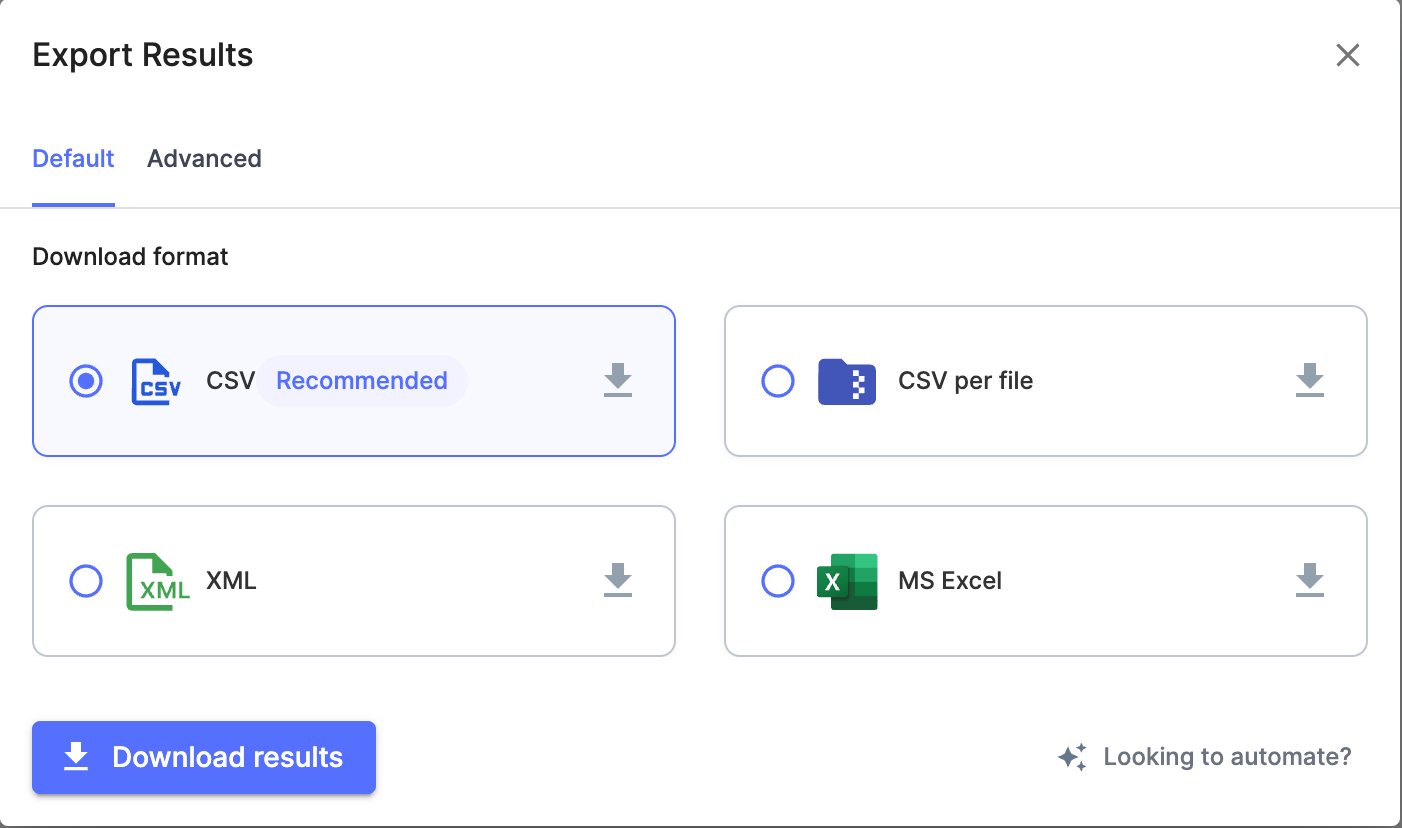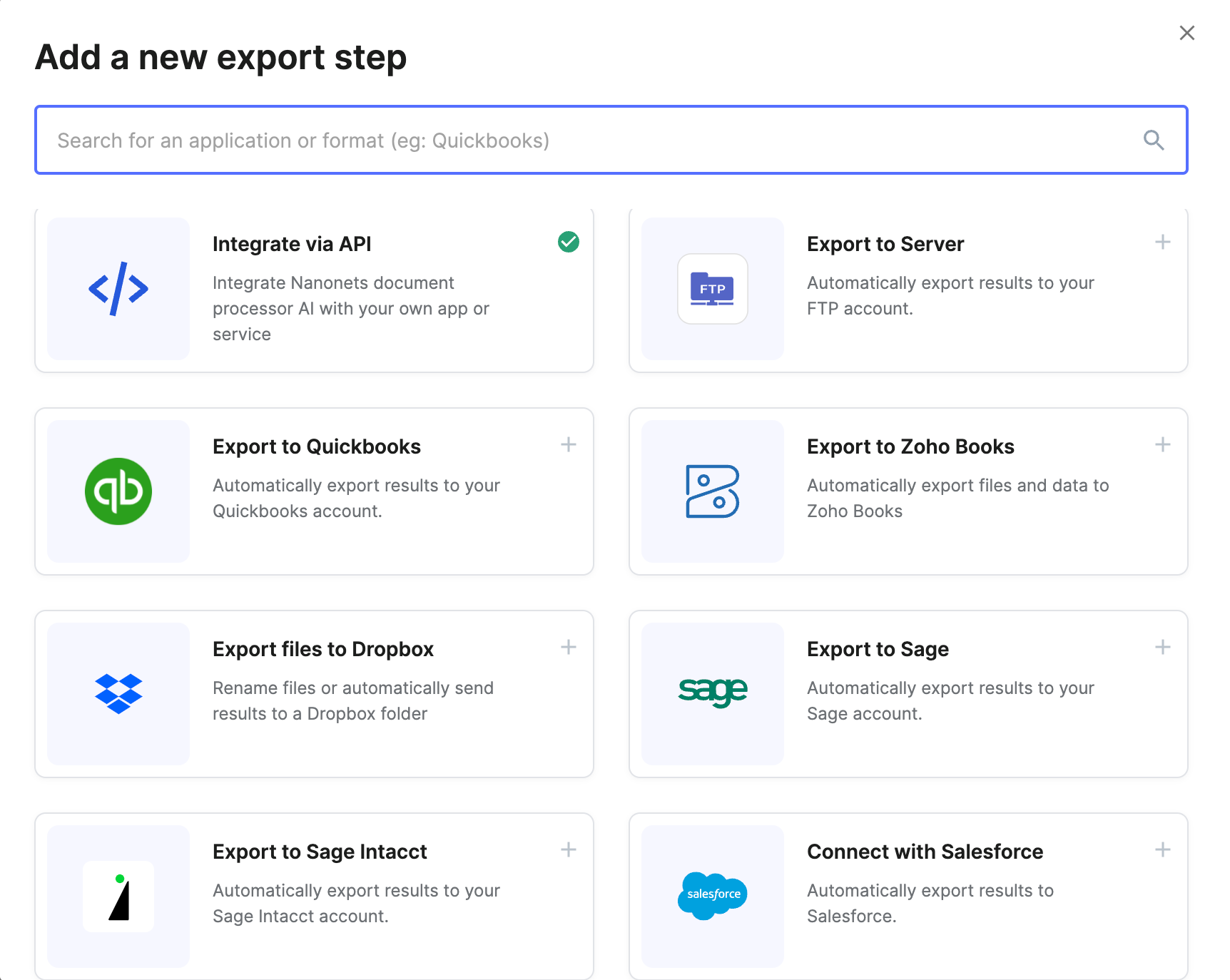PDF files are a great option for viewing, sharing and preserving data – the perfect file format for locking data. But extracting data from PDF files for further data processing or analysis can be extremely complicated.
This is one of the main reasons why PDF documents are often converted to CSV (comma separated values) format. It's much easier to edit, manipulate, and analyze data directly in a CSV file or import the CSV into spreadsheet applications like Excel or Google Sheets.
– Data is presented in an ordered structured format in which each line represents a row of data and commas separate individual values within each row.
– CSVs are compatible with most spreadsheet tools, databases and statistical analysis software.
– Most ERP, accounting software, CRM and business intelligence systems easily import CSV files for seamless data integration.
– Allows scripted processing of regular PDF report data
In this article we cover some popular methods for converting PDF to CSV files and also discuss some advanced methods aimed at more complex PDF to CSV conversion use cases.
How to convert PDF to CSV with Adobe Acrobat
Adobe Acrobat is the go-to platform for viewing and managing PDF files.
While it offers a native CSV export option, Adobe own documentation recommends The ideal is to convert PDF files first to an Excel format and then save them as CSV. This reduces the possibility of formatting errors.
Here are the steps:
- Open Adobe Acrobat. You will need the desktop version of Adobe Acrobat for this method.
- Open and export as Excel. Open the PDF file you want to convert and click Tools > Export PDF > Select Excel format (.xlsx) from the drop-down menu.
- Save as Excel. Click “Export” and choose a location to save your converted file.
- Open and save as CSV. Open the Excel file, review the formatting and check for errors, click File > Save As and choose CSV (.csv) from the drop-down menu.
How to convert PDF to CSV with Google Docs
For people who don't have a paid subscription to Adobe Acrobat, you can try a slightly roundabout way to convert a PDF document to CSV using Google Docs.
Here are the steps:
- Upload PDF to Google Drive. Click “New” > File Upload > and select the PDF file you want to upload.
- Open PDF in Google Docs. Double-click to open the PDF file in Google Drive > Open with Google Docs
- Convert text data to comma-separated values. Open the “Find and Replace” dialog box (Ctrl+F or ⌘ + F). Replace all spaces in the text with a comma (,).
- Download as .txt and rename to .csv. Click File > Download > Plain Text (.txt). Rename the downloaded file extension from .txt to .csv to convert the file to CSV.
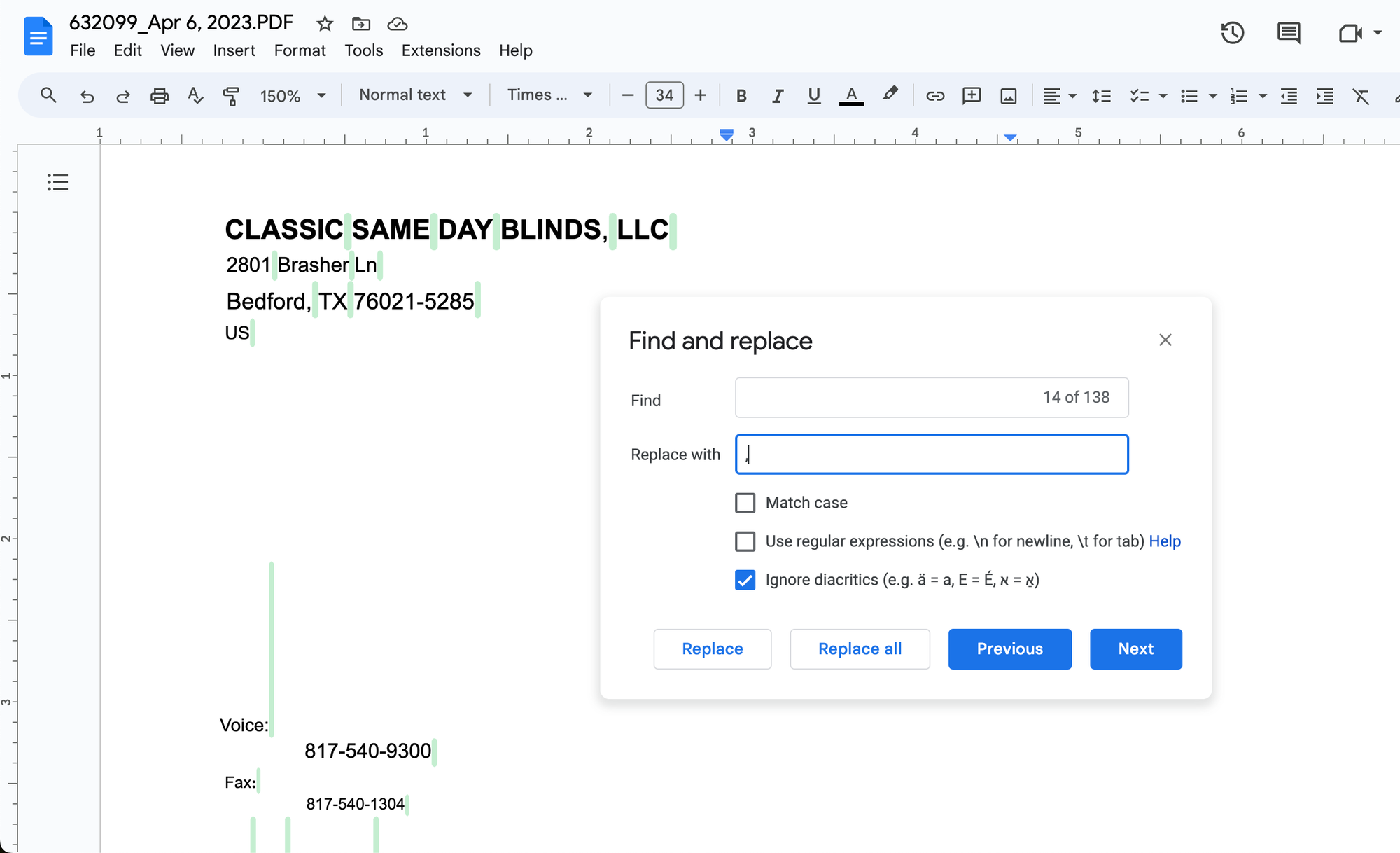
How to Convert PDF to CSV with Online Converters
The fastest way to convert PDF files to CSV files is to use a dedicated online converter like Zamzar or Convertio, among others. Simply upload a PDF and download the converted CSV in a few seconds.
These are the steps for Zamzar:
- Upload PDF. Click “Choose Files” > and select the PDF file you want to upload.
- Download converted CSV. Click “Convert Now” > wait a few seconds > and click “Download” to get the converted CSV file.
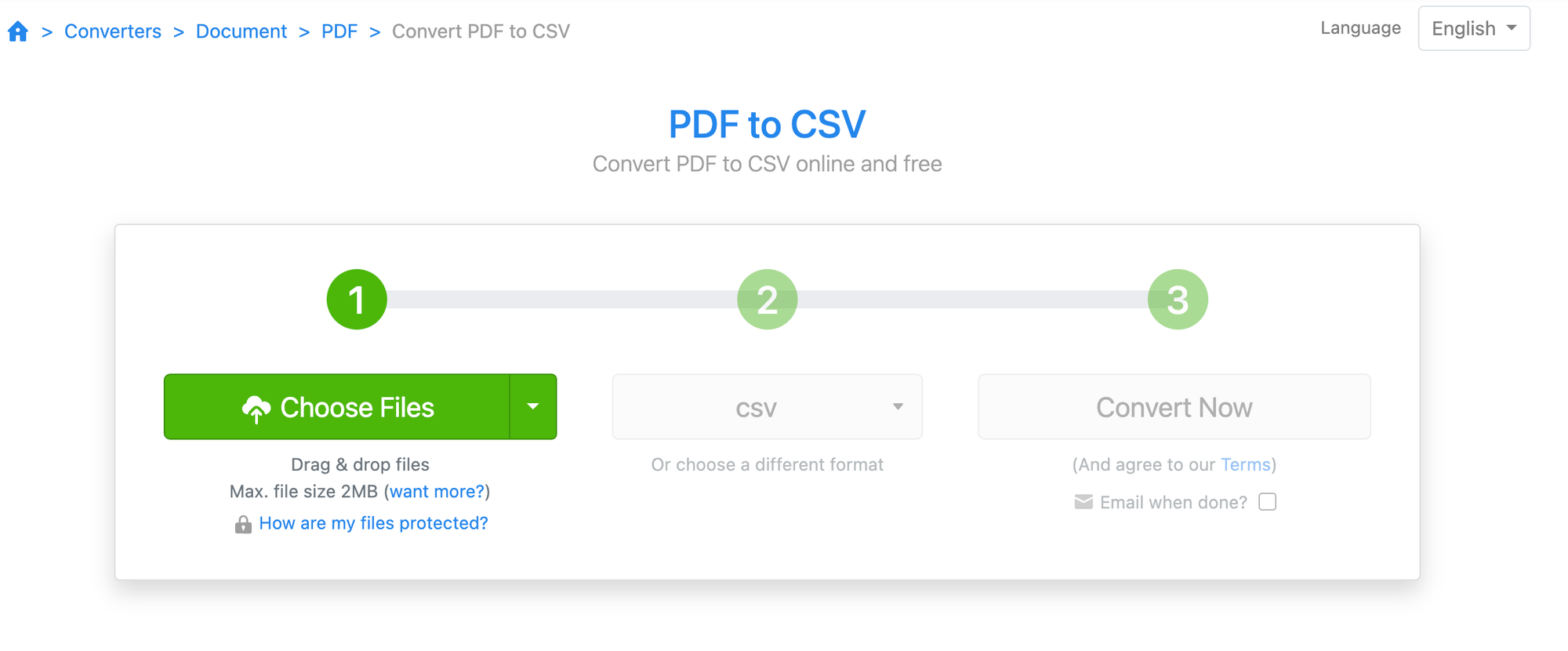
How to convert PDF to CSV using Python libraries
So far, we've mainly looked at methods that work well for unique PDF to CSV conversion use cases. They are not ideal for frequently converting large numbers of PDF documents to CSV.
Python libraries like tabula-py and camel They are ideal for batch processing and automating PDF to CSV conversion workflows.
tabula-py is generally easier to use and faster, while camel It offers more granular control and can better handle complex table structures.
Here are the steps to convert PDF files to CSV using tabula-py:
- Install tabula-py:
pip install tabula-py- Here is a Python script to convert all pages of a PDF into a single CSV file using tabula-py:
import tabula
# Path to your PDF file
pdf_path = "path/to/your/pdf/file.pdf"
# Convert PDF to CSV
tabula.convert_into(pdf_path, "output.csv", output_format="csv", pages="all")
print("Conversion completed. Check output.csv")- If you want to extract tables from specific pages or have more control over the process, you can use the
read_pdf()function:
import tabula
import pandas as pd
# Path to your PDF file
pdf_path = "path/to/your/pdf/file.pdf"
# Read PDF into a list of DataFrames
dfs = tabula.read_pdf(pdf_path, pages="all", multiple_tables=True)
# Combine all DataFrames and save to CSV
combined_df = pd.concat(dfs, ignore_index=True)
combined_df.to_csv("output.csv", index=False)
print("Conversion completed. Check output.csv")Now, let's see how to use camel To convert PDF files to CSV:
- Install camelot-py:
pip install camelot-py(cv)- Here is a Python script to convert a PDF to CSV using camelot:
import camelot
import pandas as pd
# Path to your PDF file
pdf_path = "path/to/your/pdf/file.pdf"
# Read tables from the PDF
tables = camelot.read_pdf(pdf_path, pages="all", flavor="stream")
# Combine all tables into a single DataFrame
combined_df = pd.concat((table.df for table in tables), ignore_index=True)
# Save the combined DataFrame to CSV
combined_df.to_csv("output.csv", index=False)
print(f"Conversion completed. Found {len(tables)} tables. Check output.csv")Camelot offers two methods of analysis: 'flow' and 'lattice'. The “flow” method is generally faster and works well for most PDF files, while the “lattice” method is better for PDF files with clearly defined borders.
- If you need more control or want to process tables individually:
import camelot
import pandas as pd
pdf_path = "path/to/your/pdf/file.pdf"
# Read tables from the PDF
tables = camelot.read_pdf(pdf_path, pages="all", flavor="stream")
# Process each table individually
for i, table in enumerate(tables):
table.to_csv(f"table_{i+1}.csv")
print(f"Conversion completed. Extracted {len(tables)} tables.")How to convert PDF to CSV using an LLM
If you're someone like me, who isn't comfortable working with Python libraries or anything remotely associated with coding/programming, conversational LLMs like Claude ai or ChatGPT offer a much easier alternative.
Here are the steps to convert a PDF file to CSV in Claude:
-
Upload and add a message. In the dialog box, enter something like “convert this PDF file to a CSV file.”
-
Review and download. Claude will share the converted document in a few seconds along with some insights about the original PDF file.
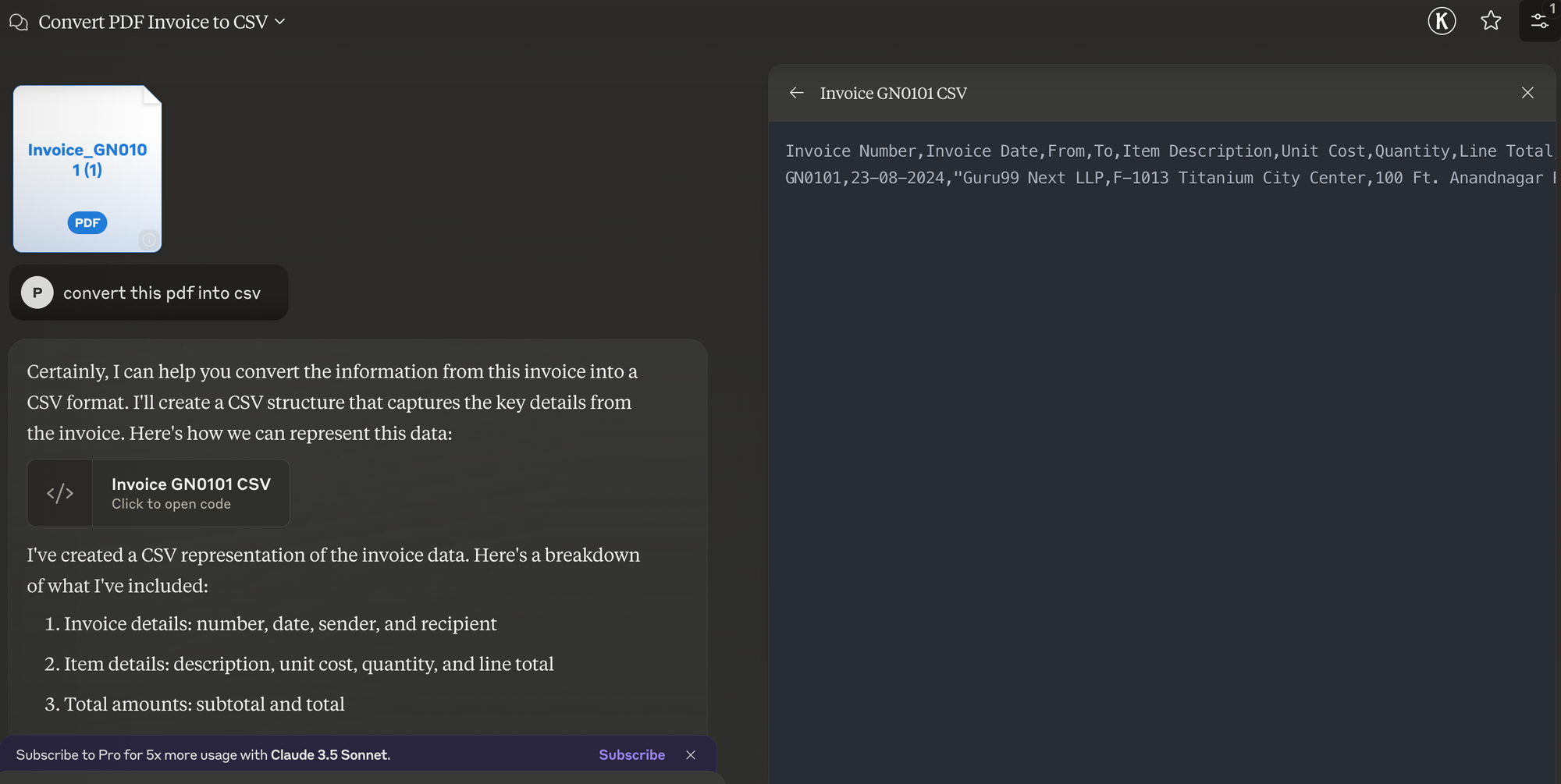
How to convert PDF to CSV using Nanonets or IDP software
All of the methods we've covered so far will probably have problems converting complex PDF files to CSV. And setting up an automated PDF to CSV conversion system using any of the above methods may not be very simple either.
Intelligent document processing solutions such as Nanonets offer the best approach to converting complex PDF files to CSV.
They are also ideal for setting up fully automated workflows or direct integrations into ERP, accounting software, or CRM (a common reason to convert to CSV in the first place).
Here are the steps to convert PDF files to CSV in Nanonets and automate the entire process:
- Register and log in. Create your Nanonets account and log in.
- Select the workflow. Select an appropriate workflow. Nanonets offers pre-built workflows for popular business documents (invoices, receipts, BoL, etc.) and a zero-shot ai extractor that can “understand” any complex document.
- Export. Export results in bulk as CSV. Or integrate directly with ERP, CRM or accounting software.
